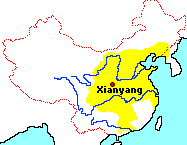|
Qin
Dynasty |
Next Dynasty |
|
|||||
 |
|
|||
|
Expanse of the Qin Dynasty |
The years leading up to 221 BC were marred by wars between the seven states of Qin, Zhao, Han, Chu, Wei, Yan and Qi. Through cunning warring matched with superior agriculture, King Zheng of Qin in 221 BC annexed the other six states and thus ended the long "Warring States" period. He styled himself as Qin Shi Huangdi -"First Emperor". Being a true "Legalist" (man is by nature undisciplined and evil and must be kept in order by fear and harsh punishment) he united the empire through the authority of a powerful, centralized state with its capital in Xianyang (20 km NW of today's Xi'an). The former states were replaced by 36 prefectures. Local customs were destroyed by burning libraries and by introducing uniform weights, measurements and currency. Also a simplified, single script was imposed to eliminate local variations but at the same time creating a core for future developments in the written language.
To the south the empire was expanded all the way to the South China Sea bringing the salt mines of Nanhai into the empire. Numerous road and canal systems were also greatly extended and systematized improving communications and further forcing political unity. Although far from the emperor's objective also commerce benefited from the improved infrastructure. The output of the vast iron ore and salt mines of the Shandong province in the east and around Shu in the southwest could now in a few weeks be transported to the center of the empire. Stimulating trade the expansion created a cash economy and a wealthy merchant class.
But the brutal suppression of dissidents and unpopularity over the vast human resources expended on the construction of The Great Wall, the infrastructure, the emperor's palace and -tomb led to an increasing number of revolts and several attempts on Qin Shi Huang's life. When the emperor decreed that 4,000 girls and boys should be entombed along with his body, his wise and powerful adviser, Li Si, managed to convince the emperor that a large terracotta army instead be created and buried around the tomb. If the soldiers depicted real figures, Li Si argued, this would be akin to the emperor taking the army, his main source of power, with him to the afterlife. Privately, Li Si feared -with good reason- that a huge killing of people however customary would cause an immediate and uncontrollable uprising.
In 210 BC the mighty but by now disillusioned and paranoid emperor died at Shaqiu (now Julu in Hebei) 50 years old while on an inspection trip to the eastern provinces. Li Si kept Qin Shi Huang's death secret and with a forged document forced the (too liberal) crown prince, Fu Su, to commit suicide instead installing Qin Shi Huang's 20 year old son, Hu Hai, as second emperor -Er Shi. Devoid of his father's strong character, however, Er Shi withdrew into an extravagant life within the palace and an unscrupulous eunuch, Zhao Gao, assumed real power. He brutally purged Li Si, senior army officers and their families and even members of the imperial family. Taxes and punishments were increased and the already restless population were finally driven to outright rebellion when peasants were conscripted for military service. In 206 BC Zhao Gao forced Er Shi to commit suicide and installed Er Shi's nephew, Zi Ying, as King of Qin effectively terminating the Qin empire. Just 46 days later the new king surrendered to the peasant leader of the rebellion, Liu Bang. A month later the king and the imperial family were beheaded and the capital and palace sacked in a fire that burned for months. The former feudal states saw the fall of the Qin empire as their opportunity to reinstate their kingdoms. By 202 BC, after 5 years of devastating war, Liu Bang, King of Han, had conquered the other kingdoms and assumed the title of emperor Gaodi of the Han Dynasty. China's second imperial dynasty was a reality! Culture: Religion & Arts: |
A United China Emperor and
Imperial Dynasties The Great Wall Many sections were added or reinforced over
the centuries, Very little unfortunately remains of The Great Wall built by Meng Jian. A few stretches remain in Guansu, Ningxia and Shaanxi provinces as does a small section north of the Yellow River in Inner Mongolia close to Baotou. Most of us today admire the relatively late constructions by the Ming north of Beijing or in Shaanxi province. The Terracotta
Warriors |